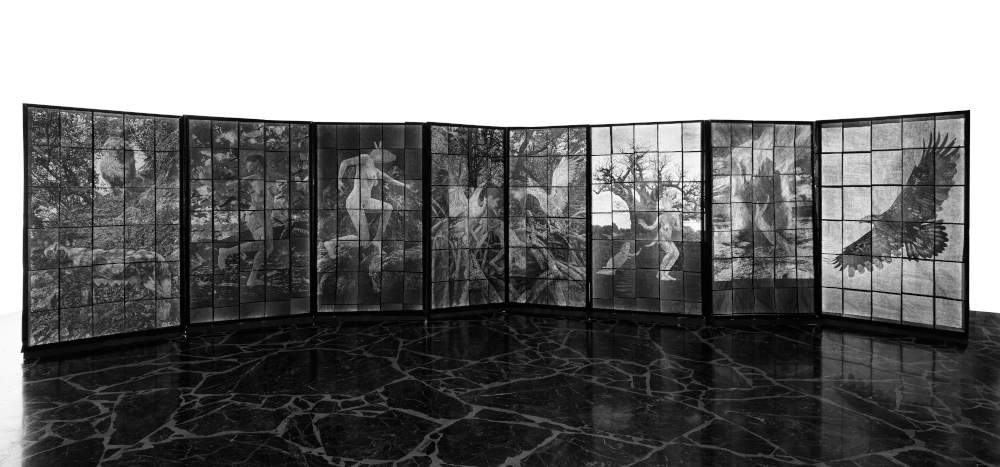From April 14 to May 11, 2022, the Italian Cultural Institute in Paris is hosting another stop on the international tour of the exhibition Cantica21. Dante Alighieri and the Italian Artists, exhibiting five works dedicated to Dante Alighieri. The scientific curatorship is by the Directorate General for Contemporary Creativity of the Ministry of Culture, in partnership with the Italian Cultural Institute in Paris.
“With this new stage of the exhibition Cantica21. Dante Alighieri and the Italian Artists in Paris,” says Director General Contemporary Creativity of the Ministry of Culture Onofrio Cutaia, “the action of internationalization of our country’s creativity by the Ministry of Culture continues, in close synergy with MAECI. The Cantica21 project represents an important opportunity for our Italian artists to engage with cultural circles abroad and a source of mutual enrichment and stimulation.”
“Contemporary art and cultural tradition come together in these works,” added Diego Marani, director of the Italian Cultural Institute in Paris, “showing that the contemporary of today is in power the classic of tomorrow. Dante with his poem was an avant-gardist and an experimenter. Together with his poetic construction that still inspires every vision of the beyond, he invented the Italian language.”
The exhibition itinerary unfolds in the spaces of the Hôtel de Galliffet, the headquarters of the Institute: on this occasion, the works are rearranged to establish an unprecedented dialogue with the rooms of the historic 18th-century building. As in the previous stage in Shanghai, the protagonist of the exhibition is the light that characterizes each work, symbolically evoking the journey made by Dante in the Divine Comedy: the total darkness of Valentina Furian’s immersive video work, the penumbra that envelops Marinella Senatore and Marta Roberti’s installations, the calibrated light for Silvia Camporesi’s photographic installation and, finally, Leone Contini’s work that lives of light.
The dark atmospheres of Inferno serve as an introduction to Ciacco, Valentina Furian’s film dedicated to the circle of gluttons, condemned to be tormented, under incessant rain, by Cerberus with his three heads. In Marinella Senatore’s work, the vision of Hell understood as a place of eternal punishment for sinners is turned on its head, signifying that even the worst sinner can find his way to redemption. With the work A salire a le stelle / To Climb To The Stars, Marinella Senatore shows Vanni Fucci’s path to redemption of the soul, pointing out how everyone can have a second chance, even more so through the language of art. Marta Roberti turns her attention to animals: the drawings that make up Bestiary of the Other World point to the metamorphic and monstrous aspect inspired by the polymorphic beings of the Comedy With her work, the artist indicates that life in the Divine Comedy can be considered an intraspecific metamorphosis. Interpreting the allegorical symbolism of Dante’s work, Silvia Camporesi has created a work consisting of unpublished drawings and photographs, also drawing inspiration from repertoires in the esoteric sphere, with the intention of verifying the symbolism of the recurring numbers present in the poem. Leone Contini’s sculpture Monte Purgatorio consists of rubble and debris that refers to the wartime destruction of recent history on top of which vegetation nevertheless sprouts, signifying that even from disasters it is possible to be reborn to new life.
The Cantica21 exhibition has a twofold purpose: on the one hand to celebrate Dante and spread knowledge around the world, and on the other to promote contemporary Italian art internationally through a selection of artists who have been able to reinterpret Dante Alighieri’s imagery in new ways.
For info: www.cantica21.it
Hours: Monday through Friday from 10 a.m. to 1 p.m. and 3 to 6 p.m.
Pictured is Marta Roberti’s installation.
 |
| Cantica21, the contemporary art exhibition dedicated to Dante Alighieri, stops in Paris |
Warning: the translation into English of the original Italian article was created using automatic tools. We undertake to review all articles, but we do not guarantee the total absence of inaccuracies in the translation due to the program. You can find the original by clicking on the ITA button. If you find any mistake,please contact us.